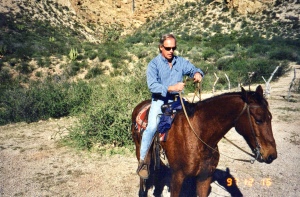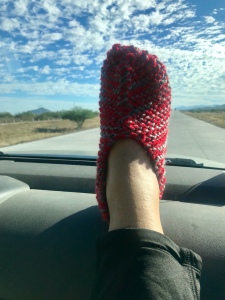We’ve just returned from a several-days respite in San Carlos, Sonora, where we visited a good friend, rode horses, watched pelicans dive-bomb for their lunch in the Sea of Cortez, ate shrimp and drank margaritas.

And quite possibly determined what our next perimeter trip will be….
I remember now why San Carlos is one of our favorite beach communities. It’s easy to get to, but not too easy, so it’s not generally as overrun by gringos as many of the better-known Mexican beach areas. The desert-meets-the-sea views are striking, the people warm and friendly, the variety of activities and goods diverse and affordable.
Oh yes, and San Carlos played a key role in our courtship nearly 20 years ago….
We left our Casita trailer behind for this 350-mile-each-way deviation from our Year on the Edges of America journey, “splurging” instead on a $32-a-night simple-but-spotless Hotel Posada del Desierto kitchenette near Marina San Carlos.
Here’s the view of Bahia San Carlos looking out our hotel door in the morning.

Astrid and her horses
The highlight of our visit was spending time with Astrid and her horses.
We’ve known Astrid since the mid-1990s, when she was the chief finance officer for the Sonora Bay Club Med and in charge of the stables; Georges used to subcontract with the Club Med to provide French-language tours across the southwestern United States.
It’s been 14 years since G has seen Astrid (nearly 18 for me!) and a lot has changed since those days.
The Club closed in 2001, for one thing. Astrid managed to keep the stables open as the property changed hands; G continued bringing tours there through at least 2005.
When it was announced a couple of years ago that the Club Med buildings would be demolished, Astrid, as determined as she is petite, promptly leased a portion of an old ejido a couple of miles away. She cleared the land and built corrals, a tack room, storage areas, feed troughs, saddle stations, a solar system, work quarters for her two workers (including a small kitchen), and her personal living quarters. She decamped with her horses to the new location last March.
The property is immaculate, the effect of her hard work impressive.


Everybody in town, it seems, knows Astrid, a native of Switzerland who speaks at least four languages. She spent nearly 20 years with the Club Med in her early years, doing the books for clubs in Europe, Asia and Africa, before coming to Mexico and falling in love with horses.

She now owns 12 horses and boards another six. She employs two local men to help, but she feeds the horses herself at sundown every day, a labor of love. Photos of her horses are on the bulletin board outside the new tack room.

We rode Gordo, Sylvestre and Ziggy this time. The horses we rode in the past (Sombra, Machete, Mariachi, et al) have mostly passed on, but Tequila, smooth-white and going-on-26, is still here. He’s asked to do duty these days only for the smallest of kids.
Check out tour guide G on a Club Med horse in 1997, photo courtesy of Astrid.

(We’d hoped also to visit Art and Ann, who we met last August at Copper Harbor on the northern tip of Michigan’s Upper Peninsula and who winter here each year. It was a six-degrees-of-separation moment when we discovered we have a friendship with Astrid in common. But they were sick with the flu while we were in San Carlos so we’ll hope to hook up with them another time.)
Our ride in and out of the rain
It was a cool, slightly overcast morning when we started our ride across the desert to revisit some of our favorite locales.
These are a couple of shots of what’s left of the set for Catch 22, starring Alan Arkin, Orson Welles, Martin Sheen, Bob Newhart and Anthony Perkins, which was filmed here nearly 50 years ago. That’s Astrid on the left, her thick, nearly knee-length braid obscured by a baseball cap and jacket.


Several other movies have been filmed in this area; on a previous ride years ago we visited the ruins of the set for The Mask of Zorro, the 1998 movie starring Antonio Banderas, Anthony Hopkins and Catherine Zeta-Jones.
It got darker and darker as we rode, and by the time we turned out of the desert toward the coast and reached the top of the hill near La Manga Dos, what had been a pleasant mist turned into a distracting drizzle. My iPhone photo looking back across the bay with the famed Tetakawi peak (“goat tit”) on the right doesn’t do the vista justice; it’s the best rained-on effort I could muster at the time.

We took temporary cover under a dilapidated ramada to wait out the rain.

About 30 minutes later, we resumed the ride. We passed the old Club Med property along the beach, the buildings now in shambles. Here’s a view of the last leg of our ride, from atop Gordo, his right ear in the foreground and Tetakawi in the distance.

We always manage to eat well
We didn’t have our traveling Casita kitchen, but we still managed to eat well. First, the margaritas. Then the seafood cocktail and G’s borracho camarones (“drunken shrimp”).



This was at the Soggy Peso near the grounds of the old Club Med. We arrived one afternoon just before the sun set, plenty of time to practice “the art of daydreaming.”


We savored a delicious dinner at Tortuga’s the next evening. Philippe, the French owner, kindly came out to chat as we relished, respectively, our fresh tuna, sea bass and coq au vin dinners.

Other impressively affordable gastronomical pleasures were had at Coralito’s, Club de Capitanes and Charly’s Rock. The photo that leads this post was taken between bites of a shared seafood molcajete at Coralito’s.
Getting there
It takes just over six hours to drive from Tucson straight south to San Carlos, known for its warm waters and rocky desert mountains. You spend the first hour on I-19, the only interstate in the nation with distances posted in kilometers. The signs date to the highway’s construction in the 1960s, amid the since-aborted national push toward the metric system.

Then you cross the border at Nogales – easy on the way down, trickier on the way back. More about that in a minute….
The roads are way improved since the last time we made this drive, with the divided, four-lane, solid concrete highway nearly complete (finally) for most of the 350 miles and posted speed limits of 90-plus kilometers per hour (60 mph-plus). You used to have to dodge the potholes and speed bumps – Mexico truly is the Land of the Topes – with posted speed limits of 40 k/ph (25 mph). It was a tedious drive.
It was great to see our favorite taco stand – Taqueria Asadero Las Brasas – still in operation in Santa Ana. New to us were the miles and miles of vineyards in and around Hermosillo, the capital of Sonora, en route to San Carlos.
Still, you have to really want to be in San Carlos to get to San Carlos; there are no easy flights in and out of neighboring Guaymas (“Arizona’s seaport”) any more. And gas costs more than $4 a gallon. But this area is part of a special tourist zone, so no special permits are necessary. All you need is a passport and car insurance.
San Carlos is home to barely 3,000 year-round residents. Its population nearly doubles in the high seasons of spring and fall as Americans and Canadians seek temperate, scenic climes. The bay’s excellent underwater visibility makes it especially popular among scuba divers. But the community retains a humble vibe that makes it a destination of quiet comfort.
Next time we come to San Carlos we’ll hike Cañon del Nacapule to see the waterfall and rock tunnel, and maybe even experience the zip line. We promised Astrid we’d not wait another 14 years to return.
Getting back
All too soon, we needed to head back north. We set out early to allow plenty of time to cross the border.
It’s a good thing we did.
We made good time for the first 270 miles or so. But then traffic came to a standstill. We waited in a long line of cars in the narrow no-man’s-land-corridor between Mexico and the U.S. to cross back into the United States.
Nogales is one of the busiest crossings along the Mexican border. It funnels some $30 billion worth of international trade into Arizona and the United States each year from Mexico and around the world through the sea port in Guaymas. Providing tens of thousands of jobs on both sides of the border, Nogales is also the oldest rail crossing of any border port of entry along the entire US-Mexico border. The rail crossing dates to 1882 and is the point through which thousands of vehicles built by the Ford Company in Hermosillo are shipped to U.S. and Canadian markets.
Only four of the 12 vehicle-inspection stations were open on this particular Saturday afternoon. It’s a good thing we’d gassed up in Magdalena. It took 95 minutes of start-and-stop inching along like a caterpillar for us to get to the head of the line. (It took longer for us to get back into the U.S. than it did for the Canadians to impound our car last July at the Maine-New Brunswick border and charge us $500 for its return.)
Our actual conversation with the U.S. border agent lasted less than 30 seconds.
This was Day 22 of President Trump’s government shutdown. We’ve no idea if that contributed to the delay. But it’s hard not to wonder how many border agents called in sick rather than work without pay.
Oh well, the trek allowed me to finish another pair knitted and crocheted booties, this set for me.

And just for grins, here’s a photo taken outside a favorite cafe on the Mexican side of Nogales, circa 1964. That’s my mother and me to the left, and cousins Charlie and Cathy and their mom, Aunt Colene, visiting from Maryland, to the right. (H/T to Cathy for finding the photo last week and texting it to me.)

Perimeter adventures to come
We learned on this trip that you can take an overnight auto ferry from Guaymas due west across 100 miles of the Sea of Cortez (aka Gulf of California) to the tiny town of Santa Rosalía, which is roughly halfway down the Baja Peninsula. G and I have been to Ensenada near the top of the peninsula and to La Paz and Cabo San Lucas at the bottom of the peninsula, but we’ve never traversed the untamed middle of the peninsula, said to be the last true frontier in this part of the world.
At about 800 miles long, the Baja peninsula is roughly the length of California, or twice the length of Florida. It ranges from 25 to 150 miles wide.
It is longer, but narrower, than the country of Italy.
 From Santa Rosalía you could drive south along the sea to Cabo and then loop around and head north closer to the Pacific coast toward El Vizcaíno Biosphere Reserve, which at more than 9,600 square miles is the largest wildlife refuge in Mexico.
From Santa Rosalía you could drive south along the sea to Cabo and then loop around and head north closer to the Pacific coast toward El Vizcaíno Biosphere Reserve, which at more than 9,600 square miles is the largest wildlife refuge in Mexico.
This route would also take you through Valle de los Cirios, a protected area of flora and fauna, before returning to the Pacific and meandering on up through the newly developed wine country near Ensenada.

The ferry runs three times a week and takes eight to 10 hours. It would cost roughly $200-$250 for the two of us and our car one way….
I feel a second perimeter trip coming on….And maybe a third….
Perimeter adventures to come. Baja in 2020, Italy in 2021?
Sounds good to me!

What a trip, no adventure, you’re having! Your next perimeters sound just as great.
LikeLiked by 1 person
We might do our last seven states (the missing interior ones) in April, getting as far north as the Ford Presidential Library. Would be great to meet you somewhere!?!?
LikeLike
Looks like life has gotten tough. I think you’ve hit on great ideas for Perimeter Travels II & III
LikeLiked by 1 person
Thanks, Bill! 😜
LikeLike
Hi there! I loved this post – of course the blast from the past photo was great fun, but being able to “see” that part of the world and learn about that area was really great – thank you! And you know I am going to find some more nostalgic pics to text your way……😘 Love to you and Georges!
LikeLiked by 1 person
❤️ Keep ‘em comin’!
LikeLike
That’s a great description of your visit, thanks for all the positive note about San Carlos, the ranch and the restaurants, it is always a pleasure to meet with you again so do not forget your promise, do not wait that long again 🙂
LikeLiked by 1 person
Thanks, Astrid. Such a pleasure to be with you, always!
LikeLike
Great post! Love the 1997 & 1964 throwback pics!
LikeLiked by 1 person
Thanks, Jane. Thank goodness for the good photo files of Astrid (in San Carlos) and Cathy (in Connecticut)!
LikeLike
I have followed your adventures all the way and have truly enjoyed your reporting. I think we all (seniors) wish we could have done the things you’ve done. A lot of things can get in the way health, money, family ties and on and on. For your own good don’t put off doing another trip. When you cruise (do nothing) you lose is true. Thanks again.
LikeLiked by 1 person
Thank you, Walter. We are blessed to have been able to make this trip work, and we look forward to more. We are so pleased that you’re “along for the ride” with us!
LikeLike
I was “concerned” when you said you were going into Mexico…I am glad it was NOT with the Casita. Even if you would have had no troubles in Mexico because of it, I can only think of what it would probably had been at the border coming back.
Sounds like it was a mellow side adventure…and without trailer complications!
LikeLiked by 1 person
Hey, Ken. Great to hear from you. Hope you and Patty are well! Yes, we decided to take only our streamlined selves into Mexico. You can’t be the price of hotel rooms there this time of year!
LikeLike